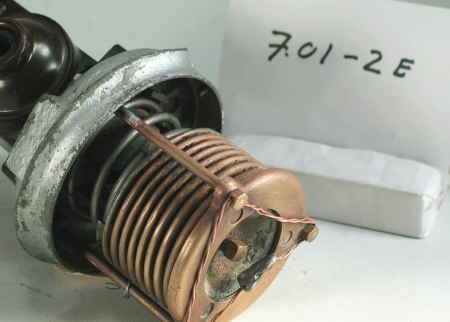Refrigerating and Air Conditioning Pressure and Temperature Controls – Household
An early, hydraulic bellows actuated, automatic temperature control [thermostat] with fixed factory setting, senses evaporator suction line temperature. Shown with collapsed bellows and fully extended compensating pressure spring. Likely an early Model E, as suggested by the absence of bellows immersion cup, Kelvinator of Canada, London, Ont. Circa 1924.
One of a rare matched set of six Kelvinator Model E thermostats profiling the evolution of one of the earliest commercially marketed, self-regulating, temperature sensing, electric motor control devices. The mode was offered by Kelvinator in various forms from 1923 through to about 1927. The set profiles: 1) the progressive design modifications made to improve performance, 2) something of the expected life expectancy of the technology in use, 3) the often precipitous modes of failure, anticipated by the refrigeration service man of the period, and 4) various stages of physical deterioration, as a result of natural use, misuse and abandonment. See numbers 7.01-2A, B, C, D, E, F.; ID # 129, 130, and 138 to 141.
Collapsed bellows [a common form of precipitous failure, indicating it has been punctured, possibly due to frost build up. and as a result lost its sulphur dioxide gas charge. As a consequence the heavy, wire wound, coil, bellows compensating spring has moved to its fully extended position.
Technical Significance:
Possibly the 1st commercially produced electric thermostat for mechanical, household, cabinet refrigerators.
Industrial Significance:
Kelvinator’s model E thermostat [temperature control], engineered for their early series household, cabinet refrigerators, is a unique study in the design and manufacture of complex automatic, analogue, mechanical switching in the early 1920’s.
Contrasting the design of the Model E thermostat, with those of some 30 years later [See R20], provides a dramatic example of the principle of progressive, engineering simplification – usually hard won.


